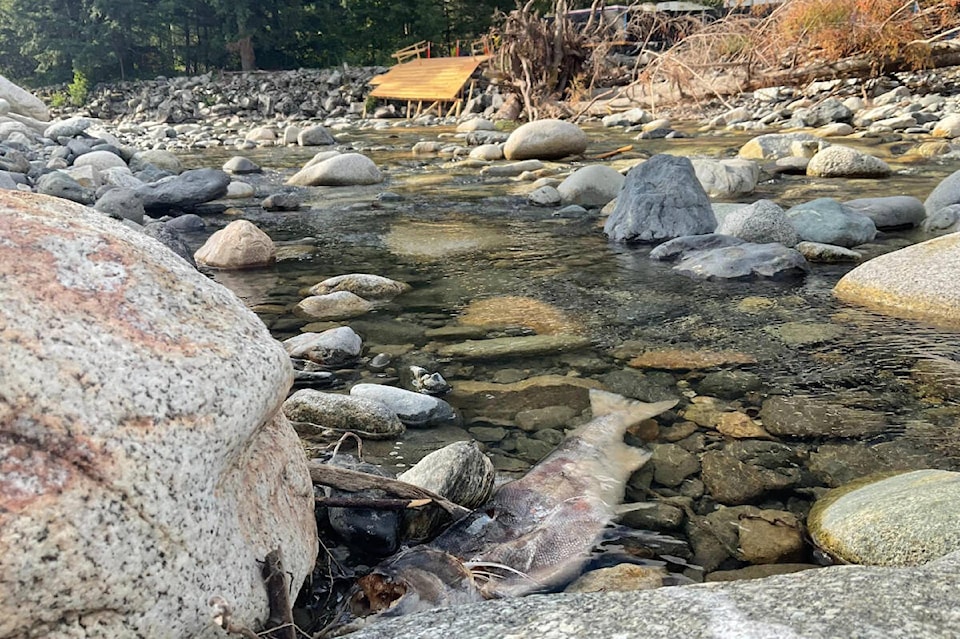Salmon are already reportedly spawning up the Coquihalla River in Hope, and they are coming up against a big obstacle.
Dr. Kate Tairyan has been chronicling the construction site where the Trans Mountain pipeline is being expanded and replaced at the Coquihalla River. She lives nearby.
She says while salmon are already making their way upstream — a critical rite of passage for their life cycle and reproduction — few are making it past the site.
The water has become murky as the stream is being diverted for the work. Heavy machinery is changing the course of the river, and fences and barricades block access to the worksite.
It’s the dead salmon that are worrying Tairyan, an SFU professor of health sciences who is familiar with her local waterways.
“It’s very unusual to see so many dead salmon in Coquihalla this early in the spawning season,” she was quoted as saying in a press release sent out Aug. 4 by an advocacy group called Protect the Planet. “I am appalled that Trans Mountain is granted permissions to carry forward with cutting a trench in the stream in an area so drastically altered by the devastating flooding of Nov 2021.”
The group includes Dr. Tim Takaro, who was arrested in 2020 for staging a protest in a tree in Burnaby. He was recently sentenced to 30 days in jail for the violation of an injunction obtained by Trans Mountain.
They’ve been tweeting out videos of the activity along the river to back up their claims, and are calling on the Department of Fisheries and Oceans to intervene and “order Trans Mountain to suspend its in-stream work until the migrating salmon have made it through.”
Yesterday it got worse - crashing and banging as they scrape through the middle of the river
— J Mo (she/her) (@jmocurran)
The area where the construction is being completed is about three kilometers from its confluence with the Fraser River. Five species of salmon as well as steelhead trout use the waterway for spawning.
Protect the Planet also asserts that Trans Mountain had started its work at the site for months ago, while their permit was valid beginning Aug. 1.
They want the construction put on hold until the end of the salmon run.
“The water levels are suitable for spawning salmon right now therefore this is the time for DFO to act to protect the salmon run,” said Dr. Takaro.
Trans Mountain is working in the area to replace part of its existing pipeline as well as install its new larger pipeline. The new pipeline will cross the Coquihalla River in multiple locations, several of which were washed out last year exposing the old pipe.
The work is expected to be completed in August, and Trans Mountain has said they will restore the river to its pre-construction state, with improvements that will fix and improve its resilience following the November 2021 flooding.
Trans Mountain responded to a request for comment with a statement regarding the local construction plan.
“Great care is taken to preserve the environmental features around the river, such as the wildlife and aquatic habitat provided within the riparian zone. During the crossing of the Coquihalla River, diversion pumps are also being used to reduce flow through the excavation area and water monitoring is taking place throughout the construction process,” a media spokesperson wrote in an email.
The full response reads as follows:
Trans Mountain is currently installing the Expansion Project pipeline under the Coquihalla River to connect the Hope Station to the north riverbank. At the same time, Trans Mountain is also replacing a segment of the existing pipeline beneath the Coquihalla River for safe continued operation of the Trans Mountain system. Trans Mountain is completing both installations simultaneously and alongside each other to limit environmental impact to the Coquihalla River and to minimize disruptions to residents.
The installation of the Trans Mountain Expansion Project and replacement of the existing pipe involves a combination of an open-cut installation beneath the riverbed and banks of the Coquihalla River and traditional trenched installation for adjacent segments. All work being undertaken is in compliance with Canada Energy Regulator-approved Environmental Protection Plans, as well as permits issued by the Department of Fisheries and Oceans Canada (DFO) and BC Oil and Gas Commission. Fish salvage work is undertaken under fish collection permits issued by the BC Ministry of Forests and DFO.
Great care is taken to preserve the environmental features around the river, such as the wildlife and aquatic habitat provided within the riparian zone. During the crossing of the Coquihalla River, diversion pumps are also being used to reduce flow through the excavation area and water monitoring is taking place throughout the construction process.
After the pipes are installed, the stream will be returned to the natural flow path and the site will be reclaimed to its original condition with additional bed and bank flood protection.
READ MORE:
READ MORE:
jessica.peters@abbynews.com
Like us on and follow us on .
Want to support local journalism during the pandemic? Make a donation




